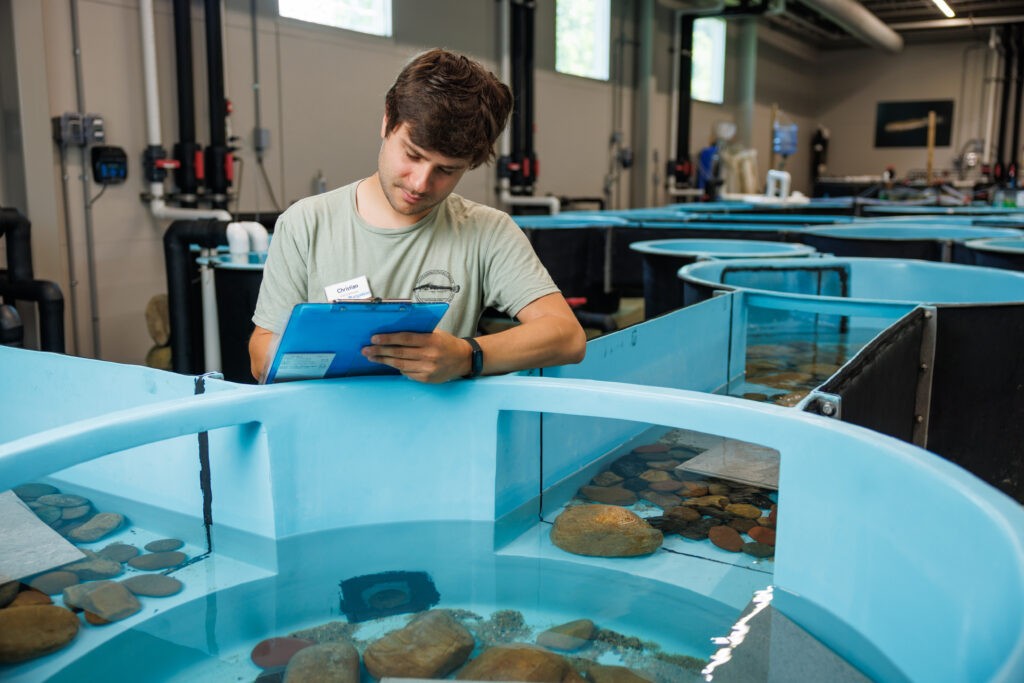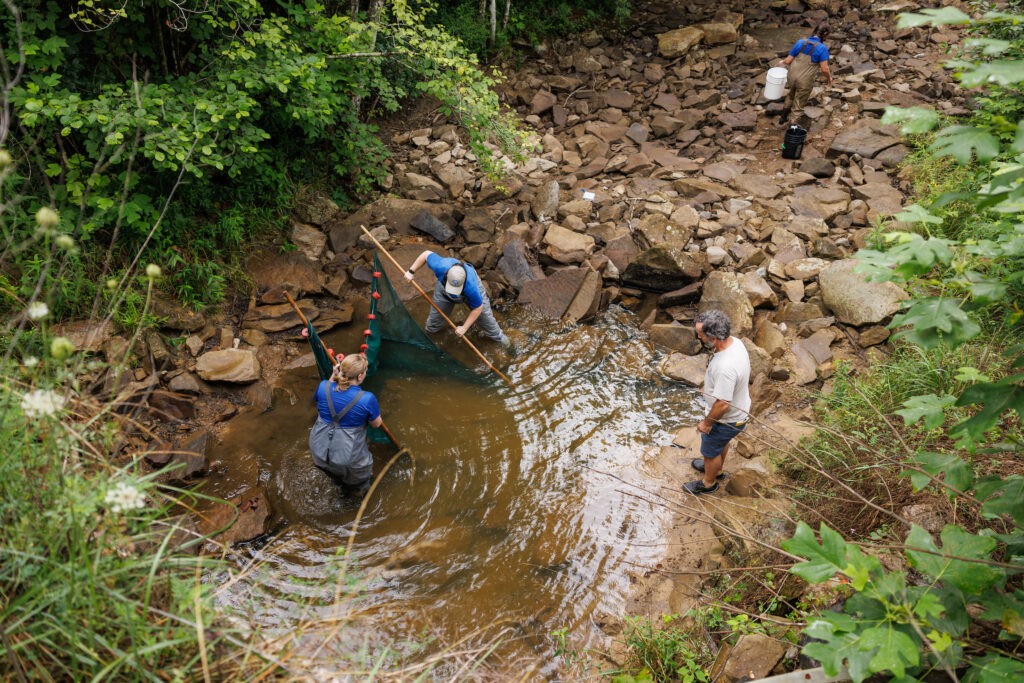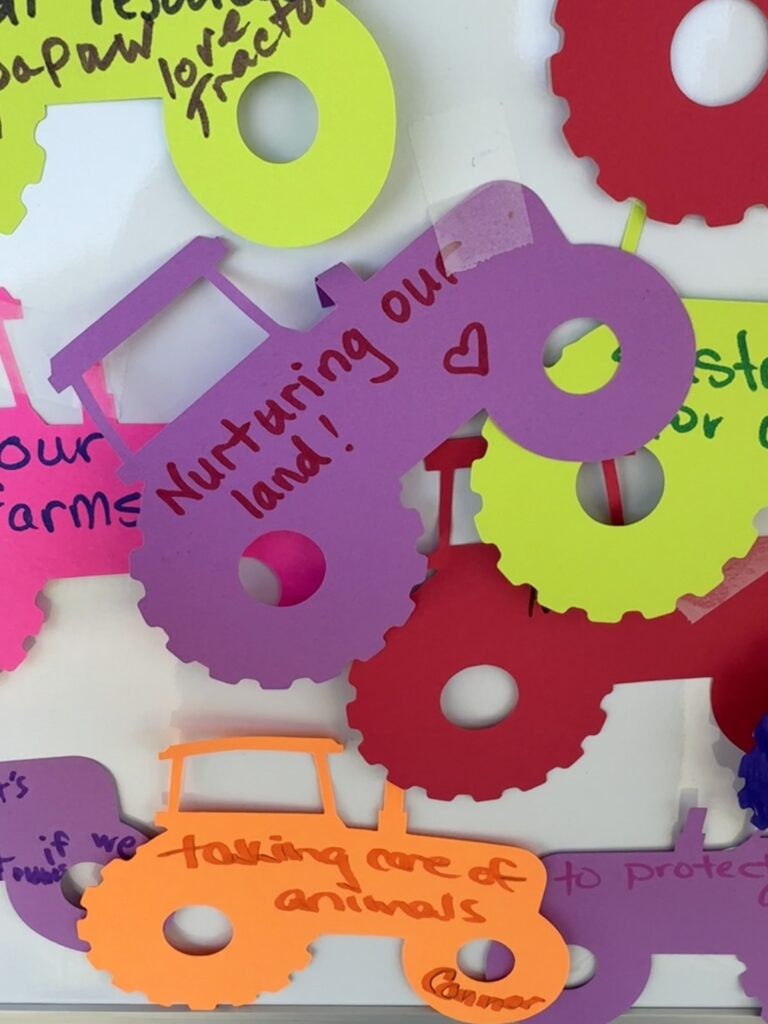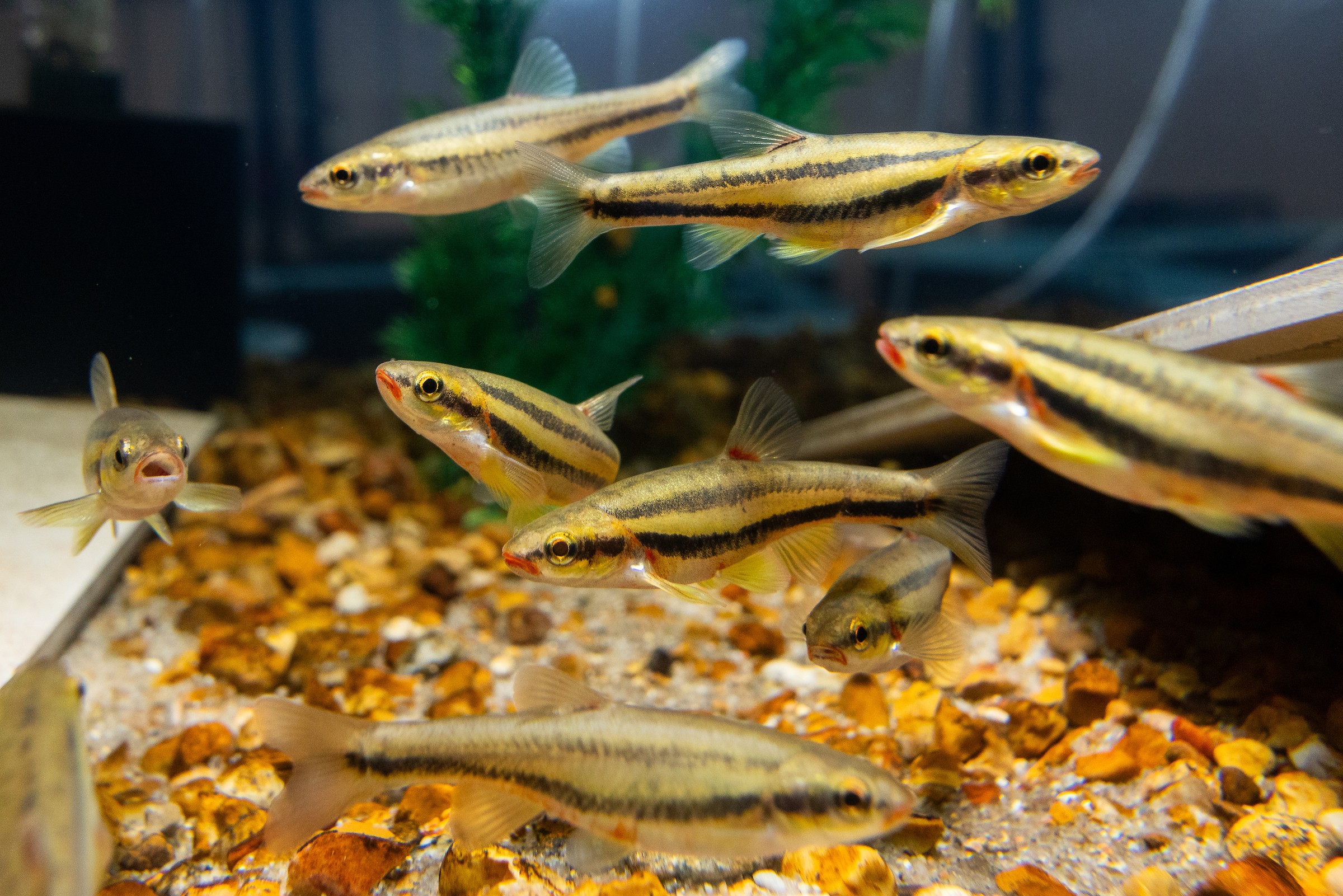A few streams on the Cumberland Plateau northeast of Chattanooga are the only places where a small freshwater fish called the laurel dace lives in the wild, so when drought struck the Southeast last summer, the species faced the real possibility of extinction.
The laurel dace has lots of challenges, from invasive species to silty streams to parasites, but weather in summer 2024 was nearly the final straw. As drought cut off its streams, leaving the laurel dace stranded in disconnected, stagnant pools, conservation scientists were forced to take action and rescue individuals from two populations for safekeeping at the Tennessee Aquarium.
Now, a small population of the laurel dace is back in their native habitat, as research and advocacy through the Tennessee Aquarium Conservation Institute (TNACI) give them a chance at survival.
“There are things we cannot control, such as drought. But, if there are any factors that we can control to protect the laurel dace. I’m excited to play a part in finding them,” said Christian Swartzbaugh, an Odum School of Ecology Ph.D. student working at the Conservation Institute to protect the minnow species.
SOUNDING THE ALARM
Swartzbaugh already was in Tennessee and researching a relative of the laurel dace when he realized the 2024 drought could be an extinction-level event for the fish. He sounded the alarm at the Tennessee Aquarium.
As wildlife conservationists considered what to do, the U.S. Fish and Wildlife Service, the Tennessee Wildlife Resources Agency and others agreed that removing the fish from its natural habitat might be the only way to save the species.

“This is not a decision that is ever made lightly. It’s alarming when you are a conservation biologist because you are working with this critically endangered species. That’s kind of like having a patient who is in the ICU,” said Dr. Anna George, the Vice President of Conservation Science & Education at the Tennessee Aquarium.
This spring, the team returned many of the fish to the stream but kept a few —called an ark population because it safeguards against extinction—at the aquarium.
STRENGTH IN NUMBERS
Swartzbaugh first became involved with the laurel dace while on a field trip to the area with Odum professors and grad students in 2023. He studies minnows – how they interact with each other and their habitat, which seemed particularly important to a fragile species like the laurel dace. The Conservation Institute had already planned to reintroduce the laurel dace into streams in its historic range and suspected that community composition would play an important role in the success of those reintroductions.
“We all got really excited about this idea of looking at the interaction of minnows specifically to benefit the laurel dace,” Swartzbaugh said. “A lot of traditional ecological theory focuses on how competition and negative interactions guide community structure in ecosystems. But the other side of that is positive interactions also occur and can be incredibly important to community structure as well. Scientists have previously shown how minnows often school together, even across species, and so maybe if we harness the power of those positive interactions, that might allow us to create a better chance of success for the laurel dace over the long term.”
While conservation scientists at the Tennessee Aquarium rear more laurel dace, the species is still so fragile that Swartzbaugh works with a cousin, the Tennessee Dace, which also is endangered, but not as critically. He spends his time observing interactions between the Tennessee dace and the blacknose dace, a common minnow that’s found in both streams where laurel and Tennessee dace live.
His research is being conducted in an artificial indoor stream at the Conservation Institute in Chattanooga. As the minnows swim around in three deep pools and connecting streams, Swartzbaugh can observe them as individuals and record their behaviors and interactions.
“Each fish is individually tagged with a unique fluorescent identifier called a Visible Implant Elastomer tag, so I can say, ‘Red left is hanging out with green right and orange left just nipped yellow right,” Swartzbaugh said. The laurel dace are spawning in another artificial stream in the same room, so he can watch the offspring and ponder how his work might help them survive.

“By understanding the interactions between the blacknose and Tennessee dace, we can infer how the laurel and blacknose dace might interact. We might be giving the laurel dace a better chance of success if we reintroduce them together,” he said.
“To be able to conduct research that answers a really interesting question and has the potential for such positive and tangible outcomes has been a dream come true,” he said.
Ecology master’s student and 2024 James E. Butler Fellow Mackenzi Hallmark also is working to give the laurel dace more of a fighting chance through the aquarium’s Ridges to Rivers project, a regional conservation partnership program (RCPP) that provides farmers in southeast Tennessee with resources to improve water quality.
COMMUNITY SUPPORT
Locals in Bledsoe and Rhea counties are invested in saving the laurel dace.
But this isn’t the first regional hero the Tennessee Aquarium has highlighted to try to engage local support for conservation. In addition to propagating and re-introducing the Barrens topminnow and two species of endangered turtles, the aquarium has worked for nearly 25 years to rebuild the lake sturgeon population in the Tennessee River that was lost in the 20th Century.
But lake sturgeon are huge—with adults as large as 250 pounds and 8 feet long—and have a historic and culture significance which makes them popular with adults and kids, said Helaina Gomez, watershed conservation coordinator for the aquarium.

“The lake sturgeon was a first example of the Tennessee Aquarium getting the community involved in restoring a native species, but lake sturgeon reintroduction happens in Chattanooga and are huge and exciting,” Gomez said. The laurel dace lives about an hour north of the city, in an agricultural watershed, where habitat degradation is a big problem for them.
“So, rallying people behind a very small fish—a 4-inch minnow that lives only in a few streams—is very inspiring,” Gomez said.
Providing avenues for people to get involved has been huge, Gomez said, since few conservation efforts are successful without local support.
Many of the people in Spring City, a town of 2,000 in Rhea County, Tennessee, deal with the same environmental challenges endangering the laurel dace, she said. The sediment entering the headwater streams where laurel dace can be found, eventually settles at the base of the plateau and flooding has become a problem in Spring City. Because the fish lives in Spring City’s backyard, it has become a symbol of strength and endurance for the community, which named the laurel dace its official fish this year.
THE HUMAN DIMENSION
In May 2025, Spring City celebrated Laurel Dace Day, to raise awareness for the fish through a road race, farmer’s market, live music and educational booths.
Hallmark had a table at the event to ask folks about conservation ag, while Swartzbaugh led an education table featuring local aquatic critters in an aquarium.
“I asked, ‘What does conservation agriculture mean to you?’ to engage them in the conversation and learn about what people may or may not know about how farms can further conservation goals,” Hallmark said. “They wrote down their answers on little cutout tractors and posted them on a whiteboard.
“You could tell there was a real sense of pride that their community is home to a fish as rare and as beautiful as the laurel dace, and I was just very grateful to get to be a part of it,” she said.
Swartzbaugh and Hallmark have given TNACI extra support in the Cumberland Plateau and with the people in Bledsoe and Rhea counties.

“One thing that I love about the Tennessee Aquarium is how they include human dimensions into their work. Conducting this research is my small contribution to solving this problem, but everything they do is with the community in mind, including how to benefit people, as well as animals,” Swartzbaugh said.
The Tennessee Aquarium Conservation Institute and the University of Georgia have strong connections through faculty at the Odum School and affiliates in the River Basin Center.
Swartzbaugh is the first student to conduct research at the Conservation Institute’s artificial streams, creating a template for how projects might work there in the future.
Hallmark’s work with farmers will help the aquarium develop conservation programs not just for the laurel dace, but for other endangered species in the future.
“We will be able to come up with solutions for situations like the one the laurel dace is that address the landowners’ needs and wildlife needs,” Gomez said. “This is an exciting time for us. We have a double whammy with Christian and Mackenzi here to help us win the race to save the laurel dace.”

